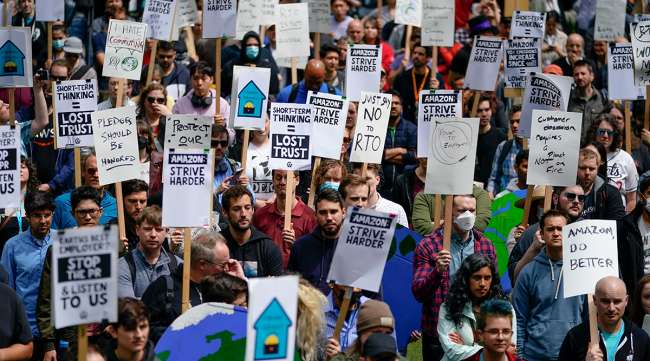Associated Press
Seattle Amazon Workers Protest Climate Goals, Layoffs

[Stay on top of transportation news: Get TTNews in your inbox.]
SEATTLE — Telling executives to “strive harder,” hundreds of corporate Amazon workers protested what they decried as the company’s lack of progress on climate goals and an inequitable return-to-office mandate during a lunchtime demonstration at its Seattle headquarters May 31.
The protest came a week after Amazon’s annual shareholder meeting and a month after a policy took effect requiring workers to return to the office three days per week. Previously, team leaders were allowed to determine how their charges worked.
The employees chanted their disappointment with the pace of the company’s efforts to reduce its carbon footprint — “Emissions climbing, time to act” — and urged Amazon to return authority to team leaders when it comes to work location.
They also objected to recent layoffs. The company has cut 27,000 jobs since November.
Wearing a black pirate hat and red coat, Church Hindley, a quality assurance engineer, said working from home allowed him to live a better, healthier life.

Hindley carries signs protesting the return-to-office requirement. (Spencer Soper/Bloomberg News)
“I’m not suited for in-office work,” Hindley said. “I deal with depression and anxiety, and I was able to get off my anxiety medication and start living my life.”
In a statement, Amazon said it supported the rights of its workers to express their opinions.
As of the morning of May 31, more than 1,900 employees had pledged to walk out around the world, with about 900 in Seattle, according to Amazon Employees for Climate Justice, a climate change advocacy group founded by Amazon workers.
Many were participating remotely, but hundreds gathered at the Amazon Spheres — a four-story structure in downtown Seattle that from the outside looks like three connected glass orbs.
Amazon, which relies on fossil fuels to power the planes, trucks and vans that ship packages all over the world, has an enormous carbon footprint. Amazon workers have been vocal in criticizing some of the company’s practices.

Amazon corporate workers hold picket signs in front of the Amazon Spheres while participating in a walkout May 31. (Lindsey Wasson/Associated Press)
In an annual statement to investors, Amazon said it aims to deploy 100,000 electric delivery vehicles by 2030 and reach net-zero carbon by 2040. But walkout organizers contend the company must do more and commit to zero emissions by 2030.
“While we all would like to get there tomorrow, for companies like ours who consume a lot of power, and have very substantial transportation, packaging, and physical building assets, it’ll take time to accomplish,” Brad Glasser, an Amazon spokesperson, said in a statement.
Glasser said there has also been a good energy on the company’s South Lake Union campus and at its other urban centers since more employees returned to the office. More than 20,000 workers, however, signed a petition urging Amazon to reconsider the return-to-office mandate.
“As it pertains to the specific topics this group of employees is raising,” Glasser said, “we’ve explained our thinking in different forums over the past few months and will continue to do so.”

Jassy
In a February memo, Amazon CEO Andy Jassy said the company made its decision to return corporate employees to the office at least three days a week after observing what worked during the pandemic. Among other things, he said senior leadership watched how staff performed and talked to leaders at other companies. He said they concluded employees tended to be more engaged in person and collaborate more easily.
In a note asking Amazon employees to pledge their participation in the walkout, organizers said Amazon “must return autonomy to its teams, who know their employees and customers best, to make the best decision on remote, in-person, or hybrid work, and to its employees to choose a team which enables them to work the way they work best.”
The walkout follows widespread cost-cutting at Amazon, where layoffs have affected workers in advertising, human resources, gaming, stores, devices and Amazon Web Services, the company’s cloud computing division.
Like other tech companies, including Facebook parent Meta and Google parent Alphabet, Amazon ramped up hiring during the pandemic to meet the demand from homebound Americans who were increasingly shopping online to keep themselves safe from the virus.
Want more news? Listen to today's daily briefing above or go here for more info
Amazon’s workforce, in warehouses and offices, doubled to more than 1.6 million people in about two years. But demand slowed as the worst of the pandemic eased. The company began pausing or canceling its warehouse expansion plans last year.
Amid growing anxiety over the potential for a recession, Amazon in the past few months shut down a subsidiary that’s been selling fabrics for nearly 30 years; shuttered Amazon Care, its hybrid virtual, in-home care service; and closed Amazon Smile, a philanthropic program.
Amazon ranks No. 19 on the Transport Topics Top 100 list of the largest private carriers in North America.




